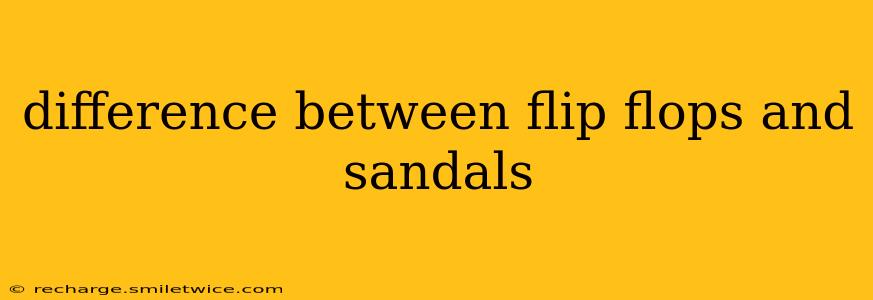Flip Flops vs. Sandals: What's the Difference?
The terms "flip-flops" and "sandals" are often used interchangeably, leading to confusion. While both are types of footwear designed for warm weather and casual wear, there are key distinctions that separate them. Understanding these differences helps you choose the right footwear for your needs and occasion.
What are Flip-Flops?
Flip-flops are a very specific type of sandal. They are characterized by a simple, Y-shaped strap that sits between the big toe and the second toe, securing the foot. The sole is typically flat and made of rubber or plastic, offering minimal arch support and cushioning. Their simplicity and ease of slipping on and off make them popular for beachwear, poolside lounging, and quick errands.
What are Sandals?
Sandals encompass a much broader category of footwear. They are characterized by straps that secure the foot to the sole, but unlike flip-flops, these straps can vary greatly in design, material, and complexity. Sandals can have multiple straps, ankle straps, heel straps, or even closed toes. The soles can also vary significantly, ranging from flat to heeled, and incorporating features like arch support, cushioning, and even different types of materials like leather, cork, or synthetic materials.
What are the Key Differences Between Flip-Flops and Sandals?
Here's a table summarizing the key differences:
| Feature | Flip-Flops | Sandals |
|---|---|---|
| Strap Design | Single Y-shaped strap between toes | Varied; multiple straps, ankle straps, etc. |
| Sole | Typically flat, rubber or plastic | Can be flat, heeled, or have arch support |
| Support | Minimal arch support and cushioning | Can offer significant arch support and cushioning |
| Materials | Primarily rubber or plastic | Wide range: leather, cork, synthetic materials |
| Style | Casual, simple | Casual to dressy; wide range of styles |
| Occasion | Beach, pool, quick errands | Diverse occasions, depending on style |
What kind of sandals are there?
This question delves into the broader category of sandals. There's a huge variety, including:
- Thong sandals: This is a more technical term for what most people call flip-flops.
- Slide sandals: These slip on easily, often with a single strap across the top of the foot.
- Espadrille sandals: These feature a woven jute sole.
- Gladiator sandals: These have many straps wrapping around the ankle and sometimes up the leg.
- Platform sandals: These have a raised sole, adding height.
- Wedge sandals: Similar to platform sandals, but the sole is sloped from heel to toe.
The possibilities are endless!
Are flip-flops good for your feet?
Flip-flops offer very little support, and prolonged wear can lead to discomfort and even foot problems. They provide minimal arch support and cushioning, which can strain your feet, ankles, and knees, especially during prolonged use. They are best suited for short periods of wear and casual situations.
Are sandals better than flip-flops?
Whether sandals are "better" than flip-flops depends entirely on your needs and the specific type of sandal. For superior comfort, support, and versatility, many sandals surpass flip-flops. However, flip-flops excel in their simplicity and ease of use.
In conclusion, while flip-flops are a specific type of sandal, sandals represent a much broader and diverse category of footwear. Understanding the distinctions helps you make informed choices based on comfort, style, and intended use.
